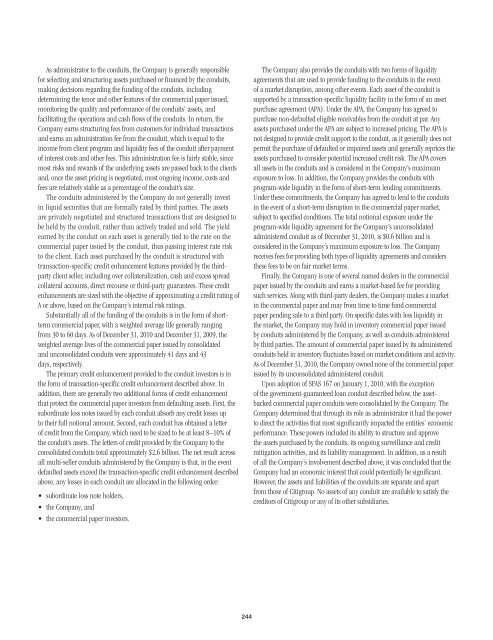Citigroup Inc.
Citigroup Inc.
Citigroup Inc.
You also want an ePaper? Increase the reach of your titles
YUMPU automatically turns print PDFs into web optimized ePapers that Google loves.
As administrator to the conduits, the Company is generally responsiblefor selecting and structuring assets purchased or financed by the conduits,making decisions regarding the funding of the conduits, includingdetermining the tenor and other features of the commercial paper issued,monitoring the quality and performance of the conduits’ assets, andfacilitating the operations and cash flows of the conduits. In return, theCompany earns structuring fees from customers for individual transactionsand earns an administration fee from the conduit, which is equal to theincome from client program and liquidity fees of the conduit after paymentof interest costs and other fees. This administration fee is fairly stable, sincemost risks and rewards of the underlying assets are passed back to the clientsand, once the asset pricing is negotiated, most ongoing income, costs andfees are relatively stable as a percentage of the conduit’s size.The conduits administered by the Company do not generally investin liquid securities that are formally rated by third parties. The assetsare privately negotiated and structured transactions that are designed tobe held by the conduit, rather than actively traded and sold. The yieldearned by the conduit on each asset is generally tied to the rate on thecommercial paper issued by the conduit, thus passing interest rate riskto the client. Each asset purchased by the conduit is structured withtransaction-specific credit enhancement features provided by the thirdpartyclient seller, including over collateralization, cash and excess spreadcollateral accounts, direct recourse or third-party guarantees. These creditenhancements are sized with the objective of approximating a credit rating ofA or above, based on the Company’s internal risk ratings.Substantially all of the funding of the conduits is in the form of shorttermcommercial paper, with a weighted average life generally rangingfrom 30 to 60 days. As of December 31, 2010 and December 31, 2009, theweighted average lives of the commercial paper issued by consolidatedand unconsolidated conduits were approximately 41 days and 43days, respectively.The primary credit enhancement provided to the conduit investors is inthe form of transaction-specific credit enhancement described above. Inaddition, there are generally two additional forms of credit enhancementthat protect the commercial paper investors from defaulting assets. First, thesubordinate loss notes issued by each conduit absorb any credit losses upto their full notional amount. Second, each conduit has obtained a letterof credit from the Company, which need to be sized to be at least 8–10% ofthe conduit’s assets. The letters of credit provided by the Company to theconsolidated conduits total approximately $2.6 billion. The net result acrossall multi-seller conduits administered by the Company is that, in the eventdefaulted assets exceed the transaction-specific credit enhancement describedabove, any losses in each conduit are allocated in the following order:• subordinate loss note holders,• the Company, and• the commercial paper investors.The Company also provides the conduits with two forms of liquidityagreements that are used to provide funding to the conduits in the eventof a market disruption, among other events. Each asset of the conduit issupported by a transaction-specific liquidity facility in the form of an assetpurchase agreement (APA). Under the APA, the Company has agreed topurchase non-defaulted eligible receivables from the conduit at par. Anyassets purchased under the APA are subject to increased pricing. The APA isnot designed to provide credit support to the conduit, as it generally does notpermit the purchase of defaulted or impaired assets and generally reprices theassets purchased to consider potential increased credit risk. The APA coversall assets in the conduits and is considered in the Company’s maximumexposure to loss. In addition, the Company provides the conduits withprogram-wide liquidity in the form of short-term lending commitments.Under these commitments, the Company has agreed to lend to the conduitsin the event of a short-term disruption in the commercial paper market,subject to specified conditions. The total notional exposure under theprogram-wide liquidity agreement for the Company’s unconsolidatedadministered conduit as of December 31, 2010, is $0.6 billion and isconsidered in the Company’s maximum exposure to loss. The Companyreceives fees for providing both types of liquidity agreements and considersthese fees to be on fair market terms.Finally, the Company is one of several named dealers in the commercialpaper issued by the conduits and earns a market-based fee for providingsuch services. Along with third-party dealers, the Company makes a marketin the commercial paper and may from time to time fund commercialpaper pending sale to a third party. On specific dates with less liquidity inthe market, the Company may hold in inventory commercial paper issuedby conduits administered by the Company, as well as conduits administeredby third parties. The amount of commercial paper issued by its administeredconduits held in inventory fluctuates based on market conditions and activity.As of December 31, 2010, the Company owned none of the commercial paperissued by its unconsolidated administered conduit.Upon adoption of SFAS 167 on January 1, 2010, with the exceptionof the government-guaranteed loan conduit described below, the assetbackedcommercial paper conduits were consolidated by the Company. TheCompany determined that through its role as administrator it had the powerto direct the activities that most significantly impacted the entities’ economicperformance. These powers included its ability to structure and approvethe assets purchased by the conduits, its ongoing surveillance and creditmitigation activities, and its liability management. In addition, as a resultof all the Company’s involvement described above, it was concluded that theCompany had an economic interest that could potentially be significant.However, the assets and liabilities of the conduits are separate and apartfrom those of <strong>Citigroup</strong>. No assets of any conduit are available to satisfy thecreditors of <strong>Citigroup</strong> or any of its other subsidiaries.244
















